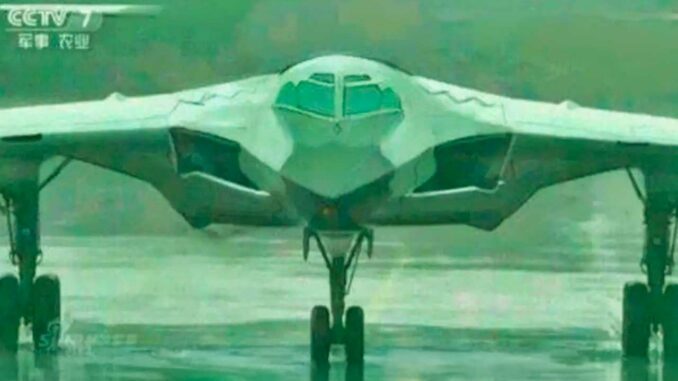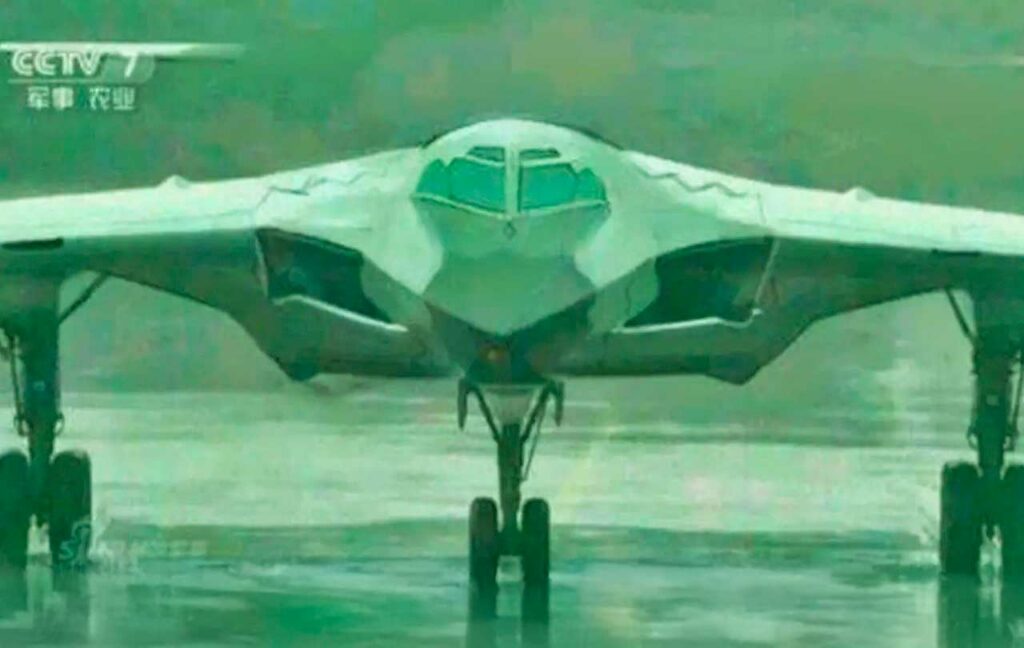
The Xi’an H-20 stealth strategic bomber is progressing, integrating China’s nuclear triad and aiming to counter US and Russian capabilities.
The People’s Republic of China is continuing to modernize its strategic forces with a long-range stealth bomber project: the Xi’an H-20. This program, under the control of the PLAAF (People’s Liberation Army Air Force), is part of a general modernization of China’s nuclear deterrent, at a time when Beijing’s military doctrine is shifting toward a more offensive posture.
This new aircraft, which has been in development since the 2000s, should enable China to achieve intercontinental airborne nuclear strike capability, thereby completing its nuclear triad alongside submarine-launched ballistic missiles and land-based intercontinental ballistic missiles. The H-20 is designed to carry conventional and nuclear long-range cruise missiles and to fly with very low radar detectability, based on the American B-2 Spirit and B-21 Raider models.
The limited information available indicates that this aircraft could be officially unveiled by 2026. The objective is clear: to reduce the vulnerability of Chinese territory by projecting nuclear power well beyond the first chain of islands in the Pacific, and to rival the strategic arsenals of the United States and Russia. This article offers a technical, strategic, and industrial analysis of the H-20 program, its concrete challenges, and its operational limitations in a context of intense aerial competition.
The design of the Xi’an H-20: a break with Chinese aerial doctrine
The Xi’an H-20 represents a major transformation in China’s strategic bombing doctrine. Unlike the H-6K, a modernized version of the Soviet Tupolev Tu-16, the H-20 adopts a flying wing configuration, inspired by the Northrop Grumman B-2 Spirit, in order to reduce its radar signature. This architectural choice indicates that China is aiming for deep penetration capability into enemy defense systems, with an aircraft that is difficult to detect on multiple radar bands.
The H-20‘s estimated range is 8,500 to 10,000 kilometers, which would allow it to strike targets on US soil from within Chinese territory without refueling in flight. The aircraft is expected to carry up to 45 tons of payload, including CJ-10K cruise missiles with conventional or nuclear warheads, with a range of 1,500 to 2,500 km according to sources. Some analysts even mention the integration of new air-to-ground hypersonic missiles currently under development.
The H-20’s flight profile is said to be optimized for high-altitude subsonic flight, but its maximum speed could reach Mach 0.95. Its coating, internal weapon bays, absence of vertical surfaces, and advanced integration of the engines into the airframe should reduce its radar cross section (RCS) to less than 0.01 m².
By opting for this model, China is breaking with its traditional doctrine of bombing based on regional deterrence. For the first time, it is equipping itself with a strategic bomber capable of engaging targets at very long ranges in an intercontinental context. This advance repositions the PLAAF as a global deterrent.

The place of the H-20 in China’s nuclear triad
Until now, the air component of China’s nuclear deterrent has been limited and symbolic. H-6K bombers are technically capable of carrying nuclear weapons, but their range exposes them to rapid interception. In comparison, the Xi’an H-20 should guarantee China a credible second-strike capability, particularly in the event of partial neutralization of its land and sea-based delivery systems.
China’s nuclear triad currently consists of:
- DF-41 and DF-31AG intercontinental missiles, carried on trucks or in silos.
- Jin-class (Type 094) nuclear-powered ballistic missile submarines (SSBNs), armed with JL-2 and soon JL-3 missiles.
- An embryonic air component, with the H-6N capable of firing an airborne ballistic missile, but without stealth or strategic range.
The introduction of the H-20 would rebalance this triad. Its stealth would give it a penetration capability that reinforces the logic of second-strike, a central condition of nuclear deterrence. The development of the H-20 therefore suggests that Beijing wants to align its deterrence with the US model, while protecting itself from an enemy first strike.
In addition, the proliferation of delivery systems makes it possible to dilute the risk for the enemy and increase uncertainty about retaliation capabilities. This logic reinforces the doctrine of “credible minimum deterrence,” which China seems to want to evolve into a posture of integrated offensive deterrence, against a backdrop of rivalry with the United States in the Indo-Pacific region.
Industrial and operational challenges of the H-20 program
The Xi’an H-20 program relies on China’s aerospace industrial ecosystem, which is dominated by AVIC (Aviation Industry Corporation of China). Production is expected to be concentrated at the facilities of Xi’an Aircraft Industrial Corporation, which is also responsible for the H-6K and Y-20.
One of the major challenges remains engines. China is still partially dependent on Russian engines such as the Soloviev D-30, which are not well suited to a stealth bomber. The WS-10 domestic engine program is operational for fighter jets, but its variants for heavy platforms pose reliability issues. A dedicated program, WS-18 or WS-20, is reportedly under development to equip the H-20, with specific thrust and thermal emissions treatment compatible with infrared stealth.
Another challenge concerns mission systems. To compete with Western standards, the H-20 must integrate a secure communications system, an autonomous electronic warfare system, advanced signature management, and a GPS jamming-resistant navigation system. These elements require a level of technological maturity that China is gradually achieving, but without operational experience.
Finally, the doctrine for its use remains unclear. A stealth strategic bomber only makes sense if it is integrated into a coherent network of early warning, inter-force communication, and nuclear command. However, China does not yet have a system equivalent to the US Global Integrated ISR. The effectiveness of the H-20 will therefore depend as much on its integration into a digital ecosystem as on its own performance.
A major strategic shift in global aeronautical and nuclear competition
The development of the Chinese Xi’an H-20 bomber must be viewed in the context of strategic competition between major powers. Beijing is seeking to achieve nuclear parity with the United States and surpass Russia in stealth air capabilities.
To date, only three countries have a stealth strategic bomber: the United States with the B-2 and soon the B-21 Raider, Russia with the still embryonic PAK DA program, and now China with the H-20. The entry into service of the H-20 would give the PLAAF access to a global power projection tool capable of targeting military installations beyond the western Pacific.
This development must also be viewed in the context of the no war, no peace strategy that Beijing is applying in its tensions with Taiwan, Japan, and AUKUS. With a stealth airborne vector, China increases the credibility of a deterrent strike, even in a non-nuclear context.
However, China also risks precipitating a new arms race in the Indo-Pacific. Japan has already doubled its defense budget. Australia is accelerating its long-range missile programs. The United States is strengthening its network of air bases in the region. If the H-20 is perceived as a direct threat, it could trigger a widespread retaliatory response that would undermine strategic stability.
War Wings Daily is an independant magazine.